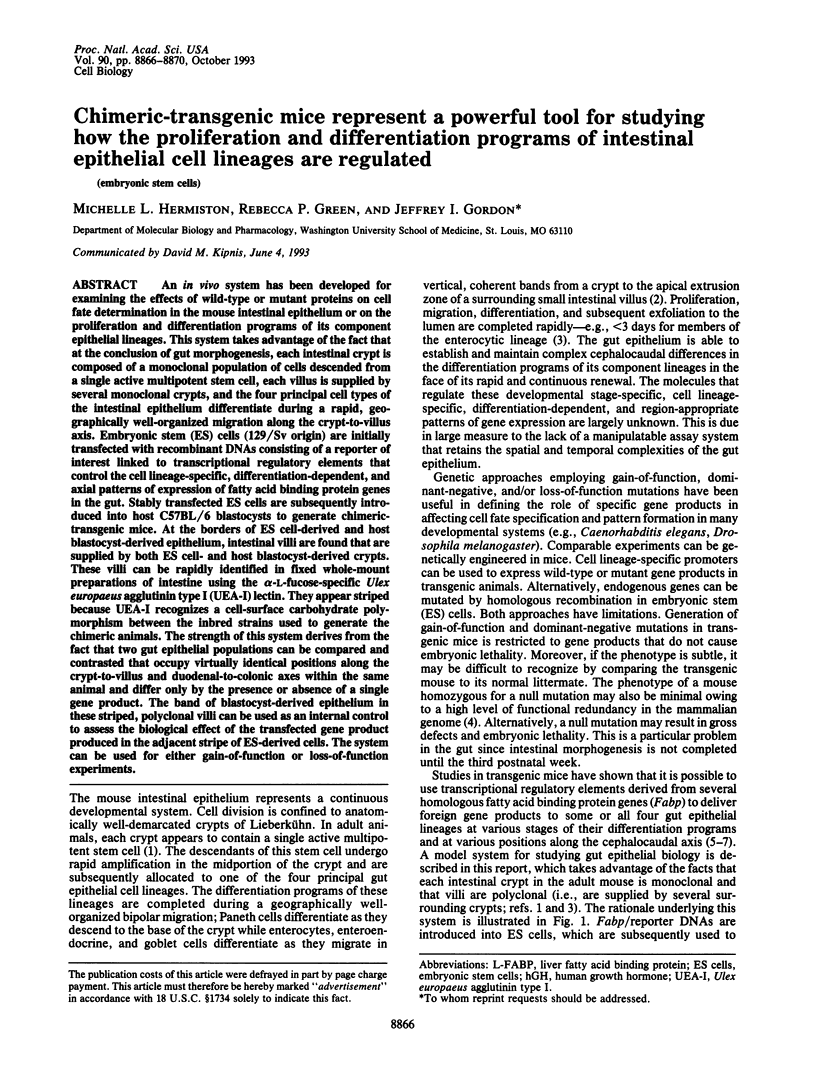Chimeric-transgenic mice represent a powerful tool for studying how the proliferation and differentiation programs of intestinal epithelial cell lineages are regulated (original) (raw)
Abstract
An in vivo system has been developed for examining the effects of wild-type or mutant proteins on cell fate determination in the mouse intestinal epithelium or on the proliferation and differentiation programs of its component epithelial lineages. This system takes advantage of the fact that at the conclusion of gut morphogenesis, each intestinal crypt is composed of a monoclonal population of cells descended from a single active multipotent stem cell, each villus is supplied by several monoclonal crypts, and the four principal cell types of the intestinal epithelium differentiate during a rapid, geographically well-organized migration along the crypt-to-villus axis. Embryonic stem (ES) cells (129/Sv origin) are initially transfected with recombinant DNAs consisting of a reporter of interest linked to transcriptional regulatory elements that control the cell lineage-specific, differentiation-dependent, and axial patterns of expression of fatty acid binding protein genes in the gut. Stably transfected ES cells are subsequently introduced into host C57BL/6 blastocysts to generate chimeric-transgenic mice. At the borders of ES cell-derived and host blastocyst-derived epithelium, intestinal villi are found that are supplied by both ES cell- and host blastocyst-derived crypts. These villi can be rapidly identified in fixed whole-mount preparations of intestine using the alpha-L-fucose-specific Ulex europaeus agglutinin type I (UEA-I) lectin. They appear striped because UEA-I recognizes a cell-surface carbohydrate polymorphism between the inbred strains used to generate the chimeric animals. The strength of this system derives from the fact that two gut epithelial populations can be compared and contrasted that occupy virtually identical positions along the crypt-to-villus and duodenal-to-colonic axes within the same animal and differ only by the presence or absence of a single gene product. The band of blastocyst-derived epithelium in these striped, polyclonal villi can be used as an internal control to assess the biological effect of the transfected gene product produced in the adjacent stripe of ES-derived cells. The system can be used for either gain-of-function or loss-of-function experiments.

Images in this article
Selected References
These references are in PubMed. This may not be the complete list of references from this article.
- Cohn S. M., Roth K. A., Birkenmeier E. H., Gordon J. I. Temporal and spatial patterns of transgene expression in aging adult mice provide insights about the origins, organization, and differentiation of the intestinal epithelium. Proc Natl Acad Sci U S A. 1991 Feb 1;88(3):1034–1038. doi: 10.1073/pnas.88.3.1034. [DOI] [PMC free article] [PubMed] [Google Scholar]
- Cohn S. M., Simon T. C., Roth K. A., Birkenmeier E. H., Gordon J. I. Use of transgenic mice to map cis-acting elements in the intestinal fatty acid binding protein gene (Fabpi) that control its cell lineage-specific and regional patterns of expression along the duodenal-colonic and crypt-villus axes of the gut epithelium. J Cell Biol. 1992 Oct;119(1):27–44. doi: 10.1083/jcb.119.1.27. [DOI] [PMC free article] [PubMed] [Google Scholar]
- Gordon J. I., Schmidt G. H., Roth K. A. Studies of intestinal stem cells using normal, chimeric, and transgenic mice. FASEB J. 1992 Sep;6(12):3039–3050. doi: 10.1096/fasebj.6.12.1521737. [DOI] [PubMed] [Google Scholar]
- Gossler A., Doetschman T., Korn R., Serfling E., Kemler R. Transgenesis by means of blastocyst-derived embryonic stem cell lines. Proc Natl Acad Sci U S A. 1986 Dec;83(23):9065–9069. doi: 10.1073/pnas.83.23.9065. [DOI] [PMC free article] [PubMed] [Google Scholar]
- Maunoury R., Robine S., Pringault E., Léonard N., Gaillard J. A., Louvard D. Developmental regulation of villin gene expression in the epithelial cell lineages of mouse digestive and urogenital tracts. Development. 1992 Jul;115(3):717–728. doi: 10.1242/dev.115.3.717. [DOI] [PubMed] [Google Scholar]
- Rossant J., Hopkins N. Of fin and fur: mutational analysis of vertebrate embryonic development. Genes Dev. 1992 Jan;6(1):1–13. doi: 10.1101/gad.6.1.1. [DOI] [PubMed] [Google Scholar]
- Roth K. A., Hertz J. M., Gordon J. I. Mapping enteroendocrine cell populations in transgenic mice reveals an unexpected degree of complexity in cellular differentiation within the gastrointestinal tract. J Cell Biol. 1990 May;110(5):1791–1801. doi: 10.1083/jcb.110.5.1791. [DOI] [PMC free article] [PubMed] [Google Scholar]
- Roth K. A., Rubin D. C., Birkenmeier E. H., Gordon J. I. Expression of liver fatty acid-binding protein/human growth hormone fusion genes within the enterocyte and enteroendocrine cell populations of fetal transgenic mice. J Biol Chem. 1991 Mar 25;266(9):5949–5954. [PubMed] [Google Scholar]
- Schmidt G. H., Wilkinson M. M., Ponder B. A. Cell migration pathway in the intestinal epithelium: an in situ marker system using mouse aggregation chimeras. Cell. 1985 Feb;40(2):425–429. doi: 10.1016/0092-8674(85)90156-4. [DOI] [PubMed] [Google Scholar]
- Simon T. C., Roth K. A., Gordon J. I. Use of transgenic mice to map cis-acting elements in the liver fatty acid-binding protein gene (Fabpl) that regulate its cell lineage-specific, differentiation-dependent, and spatial patterns of expression in the gut epithelium and in the liver acinus. J Biol Chem. 1993 Aug 25;268(24):18345–18358. [PubMed] [Google Scholar]
- Sughii S., Kabat E. A., Baer H. H. Further immunochemical studies on the combining sites of Lotus tetragonolobus and Ulex europaeus I and II lectins. Carbohydr Res. 1982 Jan 1;99(1):99–101. doi: 10.1016/s0008-6215(00)80982-9. [DOI] [PubMed] [Google Scholar]
- Sweetser D. A., Birkenmeier E. H., Hoppe P. C., McKeel D. W., Gordon J. I. Mechanisms underlying generation of gradients in gene expression within the intestine: an analysis using transgenic mice containing fatty acid binding protein-human growth hormone fusion genes. Genes Dev. 1988 Oct;2(10):1318–1332. doi: 10.1101/gad.2.10.1318. [DOI] [PubMed] [Google Scholar]
- Trahair J. F., Neutra M. R., Gordon J. I. Use of transgenic mice to study the routing of secretory proteins in intestinal epithelial cells: analysis of human growth hormone compartmentalization as a function of cell type and differentiation. J Cell Biol. 1989 Dec;109(6 Pt 2):3231–3242. doi: 10.1083/jcb.109.6.3231. [DOI] [PMC free article] [PubMed] [Google Scholar]
- Wright N. A., Irwin M. The kinetics of villus cell populations in the mouse small intestine. I. Normal villi: the steady state requirement. Cell Tissue Kinet. 1982 Nov;15(6):595–609. doi: 10.1111/j.1365-2184.1982.tb01066.x. [DOI] [PubMed] [Google Scholar]